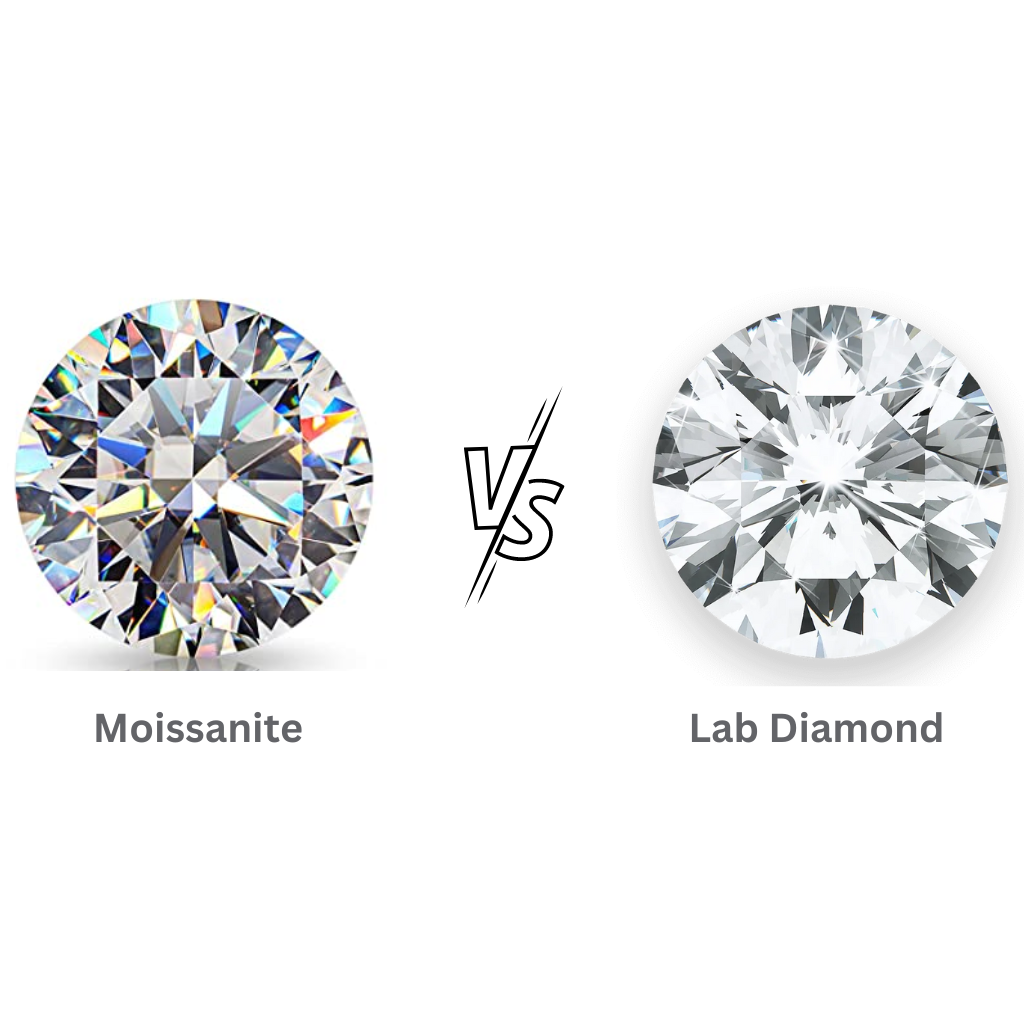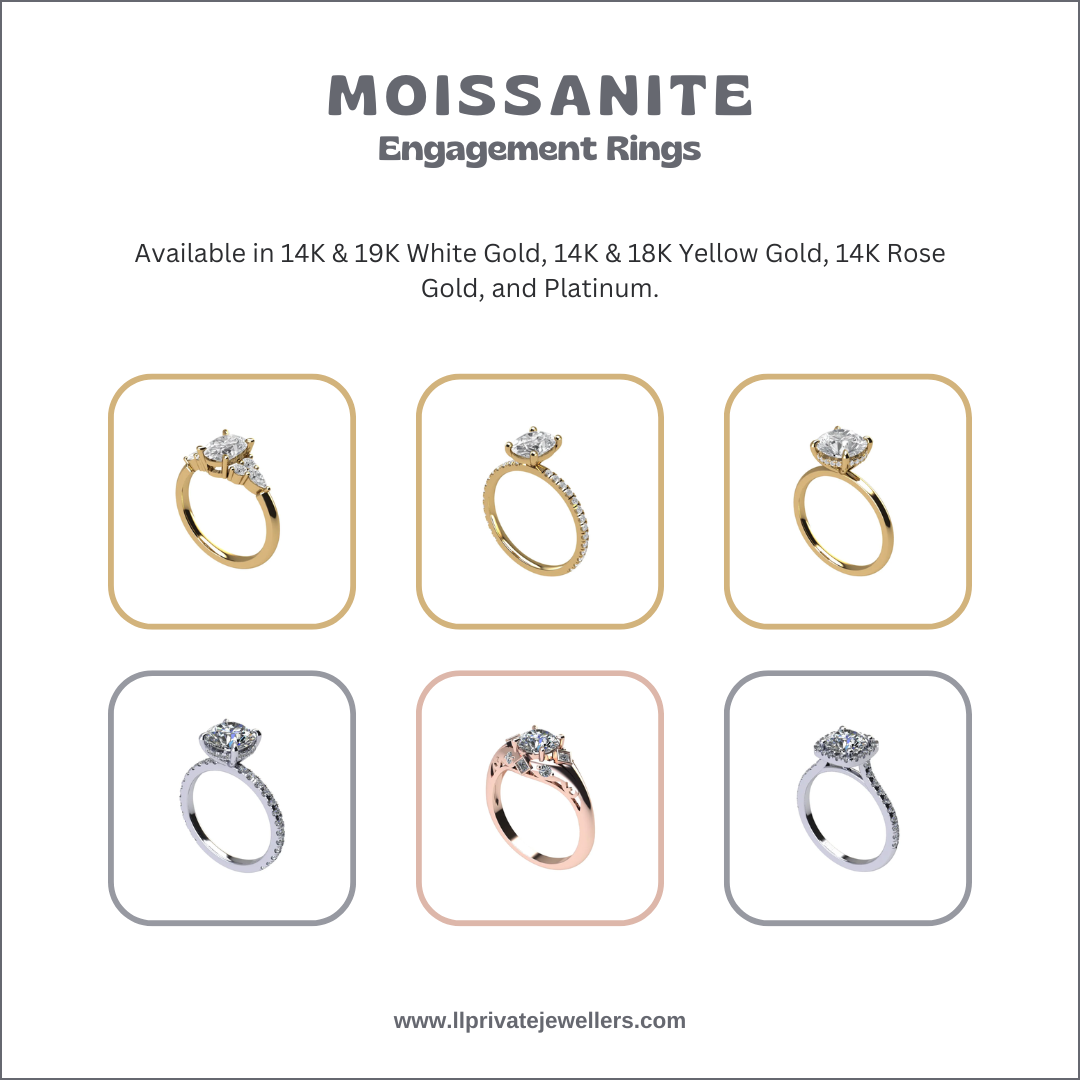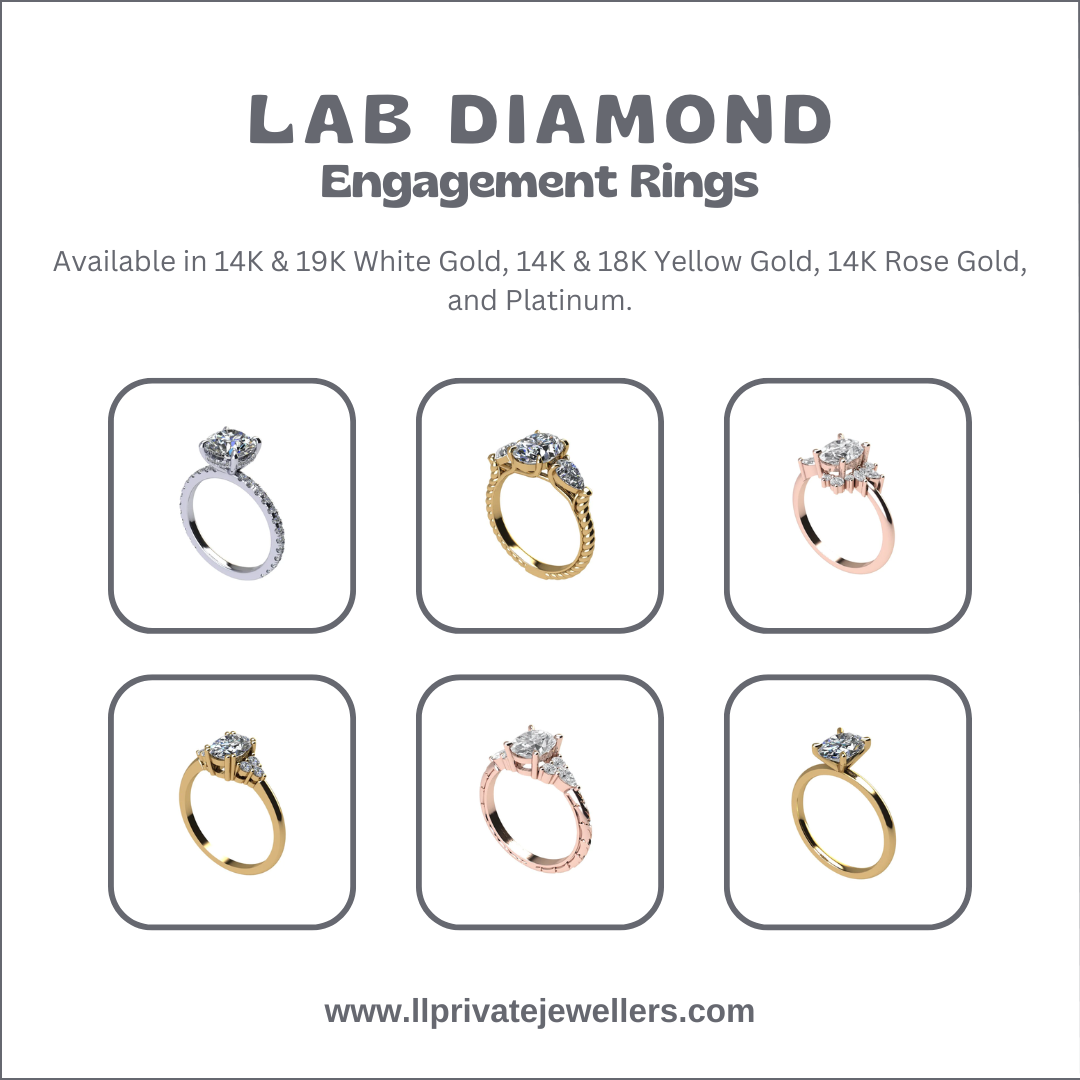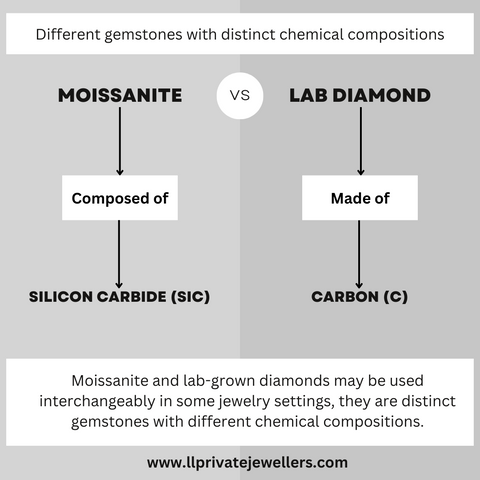Moissanite vs Lab Diamond: Here's The Difference
January 14, 2024
So, you know, when it's time to pick out that perfect gemstone for your engagement ring or any other beautiful jewelry piece, there are a couple of new kids on the block that have been getting some serious attention lately: moissanite vs lab diamond. These gems offer an exciting alternative to natural diamonds, and they've become quite the sensation. What's so cool about them? Well, they're more budget-friendly, they're ethical, and they're still incredibly stunning.
Today, we're going to discuss the difference between moissanite and lab diamond. We'll break down their properties, where they come from, and how they stack up in terms of value. By the time we're done, you'll have all the info you need to make a savvy choice for your next jewelry purchase. So, let's get started:
Moissanite vs Lab Diamond: Here's The Difference
Here is a detailed comparison of moissanite vs. lab grown diamonds:
What is Moissanite?
Moissanite is a dazzling gemstone that originated from space! In 1893, a scientist named Henri Moissan discovered tiny particles of this gem in a meteor crater, mistaking it for diamonds initially. This gemstone is composed of silicon carbide and shares many visual similarities with diamonds. It has a high refractive index, which means it disperses light better than most gemstones, resulting in a brilliant sparkle.

Lab Diamonds
So, as the name suggests, lab-grown diamonds are diamonds that are created in a controlled environment, essentially replicating the natural diamond formation process. What makes them intriguing is that they are chemically and physically identical to their natural counterparts but come with a much more budget-friendly price tag. That's not all – lab-grown diamonds also offer a conflict-free and eco-conscious alternative, which makes them a pretty appealing choice for those who care about ethical and environmental factors.

Difference Between Moissanite and Lab Diamond
1. Composition:
When it comes to composition, moissanite can be naturally occurring, but most of the moissanite used in jewelry today is lab-grown or synthetic moissanite. This makes it more accessible and affordable for those who appreciate its beauty.
When we talk about their composition, lab-grown diamonds are literally born in a laboratory. Scientists use advanced techniques to replicate the conditions under which natural diamonds are formed, and the end result is a gemstone that's essentially pure carbon (C), just like the diamonds that have been mined from the Earth for centuries.
2. Hardness:
Now, here's something interesting – moissanite is one tough gem! It's actually one of the hardest minerals known, ranking an impressive 9.25 on the Mohs scale of mineral hardness. This means it's incredibly durable and resistant to scratching, making it a great choice for jewelry that needs to stand up to daily wear and tear.
Now, here's where lab diamonds really shine – in terms of hardness. They have the same hardness as natural diamonds, scoring a perfect 10 on the Mohs scale. That's a big deal because it means they're the hardest substance on Earth, making them incredibly resistant to wear and tear. So, if you're looking for something that'll stand the test of time, lab-grown diamonds are a solid choice.
3. Brilliance and Sparkle:
Speaking of sparkle, moissanite is known for its exceptional brilliance and fire, often surpassing that of natural diamonds. Its unique optical properties create a type of sparkle that some people find even more captivating.
When it comes to brilliance and sparkle, lab-grown diamonds don't disappoint. They exhibit excellent brilliance and sparkle, closely mimicking the visual characteristics of natural diamonds. So, you get all that dazzling beauty without the hefty price tag.
4. Color:
When it comes to color, moissanite doesn't follow the same grading system as diamonds. Instead, it generally falls into the near-colorless to colorless range, although you might spot some slight color undertones in certain cases.
Now, here's a fun fact – lab diamonds come in a wide range of colors, just like their natural counterparts. You can find them in everything from colorless to fancy colored diamonds. And they're graded using the same color scale as natural diamonds, so you know you're getting something truly special.
5. Cost:
One big advantage of moissanite is its cost. It's typically more affordable than both natural and lab-grown diamonds of similar size and quality. So, if you're on a budget but still want that dazzling gemstone in your jewelry, moissanite could be the way to go.
As for the cost, lab-grown diamonds are generally more affordable than their naturally mined counterparts. However, they can be pricier than moissanite, and the exact cost depends on factors like size, quality, and where you buy them.
6. Origin:
Most moissanite available today is lab-grown. Natural moissanite does exist, but it's incredibly rare and not really used in jewelry. So, you can feel good about choosing a lab-grown moissanite, both ethically and environmentally.
And here's the cherry on top – the origin of lab diamonds is pretty ethical and environmentally friendly. They're cultivated in a controlled laboratory environment, which means they don't involve any harmful mining practices. So, you can wear your lab-grown diamond with a clear conscience.
Now that you know a bit about both moissanite and lab diamonds, which one do you find more intriguing, or do you have any more questions about them?
Moissanite Vs. Lab Diamond: Comparison Table
Here's a comparison table showcasing the differences between Moissanite and Lab Diamond
| Feature | Moissanite | Lab-Grown Diamond |
|---|---|---|
| Origin | Lab-created using silicon carbide | Lab-created using carbon, replicating the natural diamond-growing process |
| Composition | Silicon carbide | Pure carbon |
| Brilliance | Exceptionally high | Exceptionally high |
| Fire (Dispersion) | High | High |
| Color | Usually colorless | Colorless, can be found in various colors |
| Clarity | Usually eye-clean | Usually eye-clean, may have varying clarity levels |
| Hardness | 9.25 (Mohs scale) | 10 (Mohs scale) |
| Price | More affordable than lab-grown diamonds | Generally more affordable than natural diamonds |
| Ethical & Environmental Considerations | Ethically and environmentally friendly, conflict-free | Ethically and environmentally friendly, conflict-free |
| Grading & Certification | Graded using standard gemological criteria | Graded using the same criteria as natural diamonds or specific guidelines for lab-grown diamonds |
| Market Availability | Widely available | Increasingly available in the market |
| Popularity | Gaining popularity as a diamond alternative | Growing in popularity for ethical and eco-conscious reasons |
| Uniqueness | Unique gemstone with its own brilliance and fire | Each lab-grown diamond is unique, just like natural diamonds |
The 4 C's Comparison: Clarity, Color, Cut, and Carat
Clarity:
Both moissanite vs lab diamond have excellent clarity. Moissanite, being a silicon carbide gem, is created in a way that results in minimal inclusions, making it nearly flawless to the naked eye. Lab diamonds also boast high clarity levels, with minimal imperfections due to their controlled growth environment.
Color:
In terms of color, moissanite has a natural icy white appearance, which is highly sought after. On the other hand, lab diamonds offer a wide range of colors, similar to natural diamonds. You can find lab diamonds with varying color grades, including the popular "D" grade, which represents a colorless diamond.
Cut:
Both moissanite and lab diamonds can be expertly cut to reflect maximum light and sparkle. The cut is crucial as it directly affects the gem's brilliance and fire. A well-cut moissanite or lab diamond will exude unmatched brilliance, enhancing the overall beauty of the jewelry piece.
Carat:
Carat refers to the gemstone's weight and size. In terms of carat weight, moissanite is generally lighter than diamonds of the same size. For example, a one-carat moissanite might look slightly smaller than a one-carat diamond. However, this doesn't necessarily mean it is less valuable as it often depends on personal preferences and budget.
Durability Comparison
When you're thinking about a gemstone for everyday wear, you want something that can handle the daily hustle and bustle without a worry, right? Well, that's where the durability showdown comes in, pitting moissanite against lab-grown diamonds. It's like a friendly competition to see who's tougher!
Moissanite:
So, moissanite – it's kind of like the tough cookie of the gem world. This gemstone has an incredible resilience that makes it more resistant to chipping and breaking. It's like that friend who's always up for an adventure, no matter how rough it gets. On the Mohs scale of hardness, which is like a gemstone's report card for toughness, moissanite scores an impressive 9.25 out of 10. That's seriously tough!
Lab Diamonds:
But then, there are lab diamonds. These beauties are no pushovers either. They match the toughness of natural diamonds, scoring a perfect 10 on the Mohs scale. It's like having an indestructible shield in gem form. Whether it's a wild night out on the town or just another day at the office, a lab diamond is up for the challenge.
So, here's the deal: both moissanite and lab diamonds are like superheroes of durability in their own right. Moissanite brings that extra bit of toughness against chipping, while lab diamonds are the ultimate in scratch resistance. Whichever one you choose, you're signing up for a gem that's ready for life's adventures, just like you are!
Price Comparison
You know, when it comes to picking the perfect gem, your budget often plays a significant role. So, here's the price comparison of moissanite vs. lab diamond:
Moissanite:
Now, moissanite is like that budget-friendly friend who always knows how to have a good time without breaking the bank. When it comes to price, moissanite typically comes in as the more affordable option. You can get a stunning moissanite gem that mimics the brilliance of a diamond without the hefty price tag that often comes with natural diamonds.
Lab-Grown Diamonds:
On the other hand, lab-grown diamonds offer an exciting middle ground. They're usually priced lower than natural diamonds, but they can be a bit more expensive than moissanite. The exact cost depends on factors like size, quality, and where you buy them. However, you still get that beautiful diamond look and feel without the high price associated with mined diamonds.
So, it's kind of like a budget-friendly showdown here:
Moissanite takes the lead in affordability, making it an excellent choice if you're looking for that diamond-like sparkle without breaking the bank. Lab-grown diamonds, while not as budget-friendly as moissanite, still offer a significant savings compared to natural diamonds, making them a compelling option for those who want the real deal without the premium price tag.
Ultimately, the choice comes down to your budget and how much you're willing to invest in your gemstone. Both moissanite and lab diamonds offer fantastic value, so it's all about finding the perfect balance between your wallet and your desires.
Environmental and Ethical Considerations
When choosing a gemstone, it's not just about its beauty and price but also the impact it has on the environment and society. Let's explore the environmental and ethical aspects of moissanite and lab-grown diamonds:
Moissanite:
- Ethical Sourcing: Most moissanite on the market is lab-grown, which means it's produced in controlled environments. This eliminates concerns related to unethical mining practices, labor issues, and conflict diamonds, making moissanite a more ethically sourced option.
- Environmental Impact: The production of lab-grown moissanite tends to have a lower environmental footprint compared to mining natural diamonds. It requires fewer resources and doesn't involve the disruption of ecosystems through mining operations.
Lab-Grown Diamonds:
- Ethical Sourcing: Lab-grown diamonds are also considered an ethical choice. They are produced under strict regulations, and the supply chain is generally transparent. This means you can be more confident that your gemstone hasn't been associated with unethical practices.
- Environmental Impact: Lab-grown diamonds are often viewed as a more environmentally friendly option compared to natural diamonds. They don't require extensive mining operations, reducing the damage to the Earth's surface. Additionally, the energy used in their production is becoming more sustainable over time.
Brilliance and Fire: The Sparkle Factor
Now, when it comes to sparkle, both of these gems are like stars in the night sky, but they've got their own unique ways of lighting up a room!
Moissanite:
Moissanite is like the dazzling showstopper in the world of gemstones when it comes to brilliance and fire. It boasts exceptional sparkle, often rivaling or even surpassing that of natural diamonds. This gemstone has a unique ability to disperse light in a way that creates vivid flashes of color, giving it a mesmerizing and fiery appearance. If you're all about that radiant and intense sparkle, moissanite might be your go-to choice.
Lab-Grown Diamonds:
Lab-grown diamonds are no slouch in the sparkle department either. They closely mimic the brilliance and fire of natural diamonds, which is one of the reasons they're so highly sought after. These gems are cut and faceted to maximize their light performance, resulting in a captivating and scintillating display. If you're after the classic diamond sparkle that's both elegant and timeless, lab-grown diamonds deliver it with flair.
So, it's like a friendly sparkle-off between moissanite and lab-grown diamonds. Moissanite shines with its exceptional brilliance and fiery flashes of color, creating a unique and dazzling show. Lab-grown diamonds, on the other hand, offer that classic, timeless sparkle that has made diamonds famous for centuries.
Is moissanite a lab grown diamond?
No, moissanite is not a lab-grown diamond. While both moissanite and diamonds are used in jewelry and share some visual similarities, they are entirely different gemstones with distinct chemical compositions. Moissanite is composed of silicon carbide (SiC), whereas diamonds are made of carbon (C).

Moissanite was originally discovered in 1893 in a meteor crater and later found in nature in very rare quantities. Due to its scarcity, scientists developed a method to create moissanite in a laboratory setting, making it more readily available for use in jewelry. It is often used as a diamond alternative due to its brilliance and durability, but it is a separate gemstone with its own unique properties. Lab-grown diamonds, on the other hand, are true diamonds with the same carbon structure as naturally occurring diamonds, created in a controlled laboratory environment.
So, while moissanite and lab-grown diamonds may be used interchangeably in some jewelry settings, they are distinct gemstones with different chemical compositions.
Moissanite or Lab Diamonds: The Personal Preference
Choosing between moissanite and lab-grown diamonds often boils down to personal preference, and it's a bit like selecting your favorite flavor of ice cream. Both are delightful options, but what speaks to you may not be the same as what appeals to someone else. Here's how personal preference can influence your decision:
Moissanite:
- If you're all about affordability and want a beautiful gemstone that won't break the bank, moissanite might be your top pick.
- Moissanite's exceptional brilliance and fiery flashes of color can be a real draw for those who love a dazzling and unique sparkle.
- Some people appreciate the ethical and eco-friendly aspect of choosing a lab-grown gem, even if it's not a diamond.
Lab-Grown Diamonds:
- If you're after a gem that closely mimics the appearance and properties of natural diamonds, lab-grown diamonds are a compelling choice.
- Lab diamonds offer the classic, timeless sparkle that has made diamonds a symbol of enduring love and elegance for generations.
- If you value the idea of having a real diamond without the ethical concerns associated with mined diamonds, lab-grown diamonds provide a clear conscience.
Maintenance and Care
Maintenance and Care for Moissanite:
-
Cleaning: Moissanite is quite durable, but it can still accumulate dirt and oils over time. To clean it, you can use warm, soapy water and a soft brush or cloth. Gently scrub the moissanite and rinse it thoroughly to remove any residue. Regular cleaning helps maintain its brilliance.
-
Avoid Harsh Chemicals: While moissanite is resistant to most chemicals, it's a good practice to avoid exposing it to harsh cleaning agents or chemicals. These can potentially dull its sparkle over time.
-
Storage: When you're not wearing your moissanite jewelry, store it separately from other jewelry to prevent scratching. You can use a soft pouch or jewelry box with individual compartments to keep it safe.
Maintenance and Care for Lab-Grown Diamonds:
-
Cleaning: Lab-grown diamonds can also accumulate dirt and oils, affecting their sparkle. To clean them, you can follow the same method as for moissanite – warm, soapy water and a soft brush or cloth. Gently clean and rinse the diamond to maintain its brilliance.
-
Avoid Harsh Chemicals: Just like with moissanite, it's best to avoid exposing lab-grown diamonds to harsh chemicals or abrasive cleaning agents that could potentially harm the setting or the metal in your jewelry.
-
Regular Inspections: Periodically inspect your jewelry settings to ensure that the lab-grown diamond is securely in place. If you notice any loose prongs or settings, have them repaired promptly to prevent any loss.
-
Professional Cleaning: Consider getting your lab-grown diamond jewelry professionally cleaned and inspected by a jeweler at least once a year. They can also check for any potential issues with the setting and make any necessary adjustments.
-
Storage: When not wearing your lab-grown diamond jewelry, store it in a safe place, preferably in a jewelry box or pouch to protect it from dust and scratches. Consider storing each piece separately to prevent contact with other jewelry.
In both cases, it's essential to handle your jewelry with care to maintain its beauty over time. Regular cleaning and proper storage can go a long way in keeping your moissanite or lab-grown diamond jewelry looking as stunning as the day you got it. - Read How To Clean Your Jewelry?
Also Read:
Lab Grown Diamonds vs Natural Diamonds
Conclusion
Whether you choose moissanite or lab diamonds, you'll have a stunning gemstone that shines brightly and symbolizes love and commitment. Moissanite offers an affordable and radiant option with exceptional fire, while lab diamonds combine beauty and ethics to create a truly dazzling choice.
Remember, when making your decision, consider your budget, personal style, and ethical values. Regardless of your choice, both moissanite vs lab diamond offer brilliant alternatives to natural diamonds, ensuring your jewelry piece will be cherished for a lifetime.
Discover the brilliance that reflects your unique style. Contact LL Private Jewellers today to create your dream jewelry piece!
Frequently Asked Questions (FAQs) about Moissanite vs. Lab Diamond
What is the primary difference between moissanite and lab diamonds?
Moissanite is a naturally occurring gemstone composed of silicon carbide, while lab diamonds are man-made diamonds created in controlled environments using advanced technology.
Is moissanite lab created?
Yes, moissanite is primarily lab-created. It's important to note that moissanite is a lab-grown gemstone, not a lab diamond. While natural moissanite does exist, it is extremely rare, typically found only in minute quantities within certain types of meteorites and as small inclusions in other minerals. Due to this rarity, almost all moissanite available in the market is synthetically produced in laboratories.
The lab creation process of moissanite involves using silicon carbide (SiC), which is subjected to high temperatures and pressures to grow large crystals. These crystals are then cut and polished to create the gemstones that are used in jewelry. This process ensures that lab-created moissanite has the same chemical and physical properties as naturally occurring moissanite.
Is moissanite better than diamond?
Moissanite and diamonds each have their unique qualities. Moissanite offers exceptional brilliance, affordability, and ethical advantages. Diamonds, on the other hand, come with tradition, rarity, and symbolic value. The choice depends on personal preferences and priorities, such as budget, tradition, or environmental concerns
Are moissanite and lab diamonds real gemstones?
Yes, both moissanite and lab diamonds are real gemstones. Moissanite occurs naturally in small quantities, and lab diamonds have the same chemical composition as natural diamonds.
Can you tell the difference between moissanite and lab diamonds with the naked eye?
To the untrained eye, it can be challenging to distinguish between moissanite and lab diamonds. However, gemologists can differentiate them using specialized equipment.
Is moissanite as good as a diamond?
Moissanite and diamonds each have their unique qualities. Moissanite often surpasses diamonds in brilliance and affordability, making it an attractive choice for many. However, diamonds hold a special status and tradition, symbolizing enduring love and prestige. Whether moissanite is as good as a diamond depends on individual preferences and priorities, such as budget, tradition, and personal symbolism.
Is moissanite harder than diamond?
No, moissanite is not harder than a diamond. In fact, diamonds are the hardest natural material known, ranking at the top of the Mohs scale of mineral hardness with a perfect score of 10. Moissanite, while still exceptionally hard, ranks slightly lower on the Mohs scale with a rating of 9.25. This means that diamonds are more resistant to scratching and abrasion compared to moissanite.
For more information about gemstones, please feel free to contact us!
